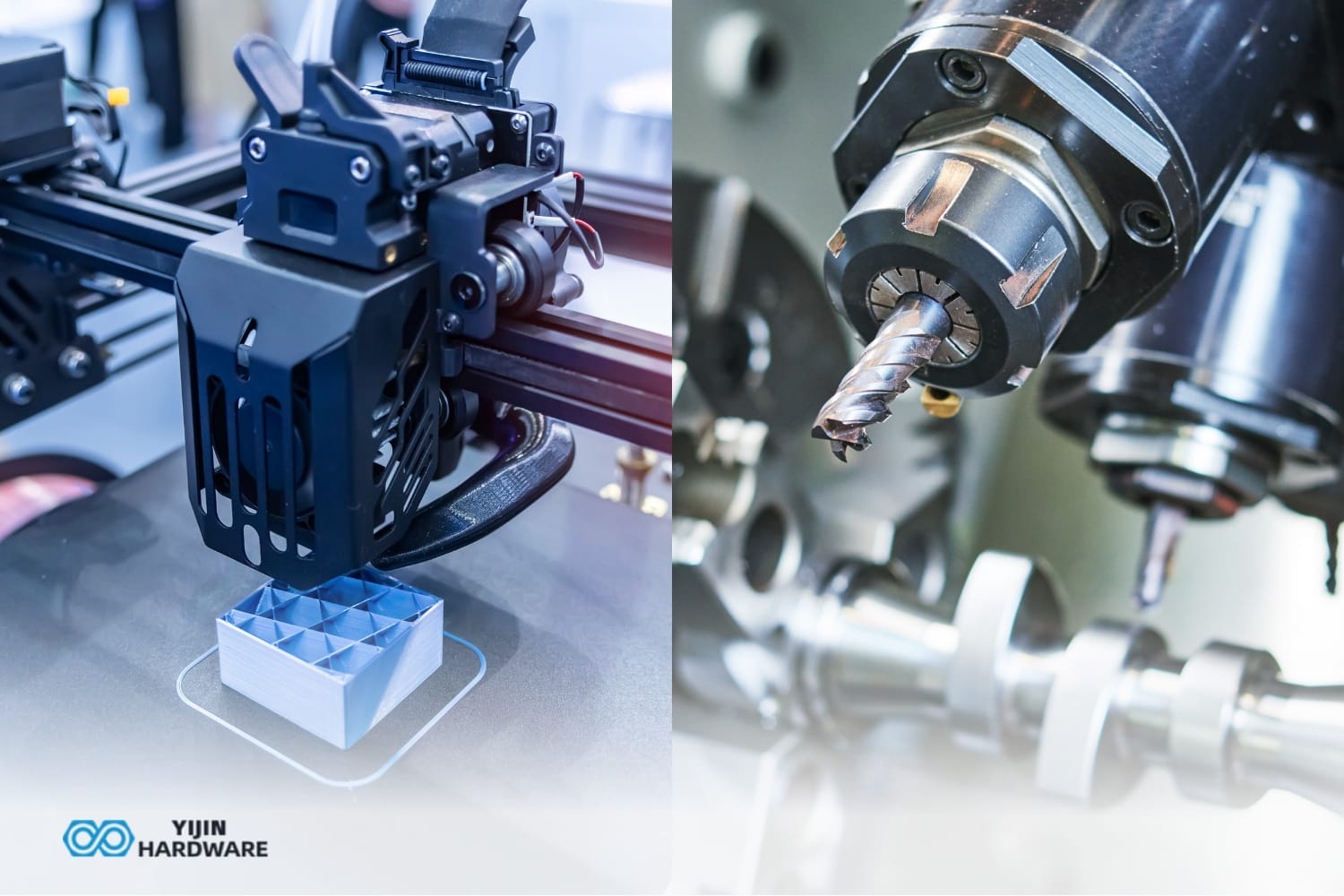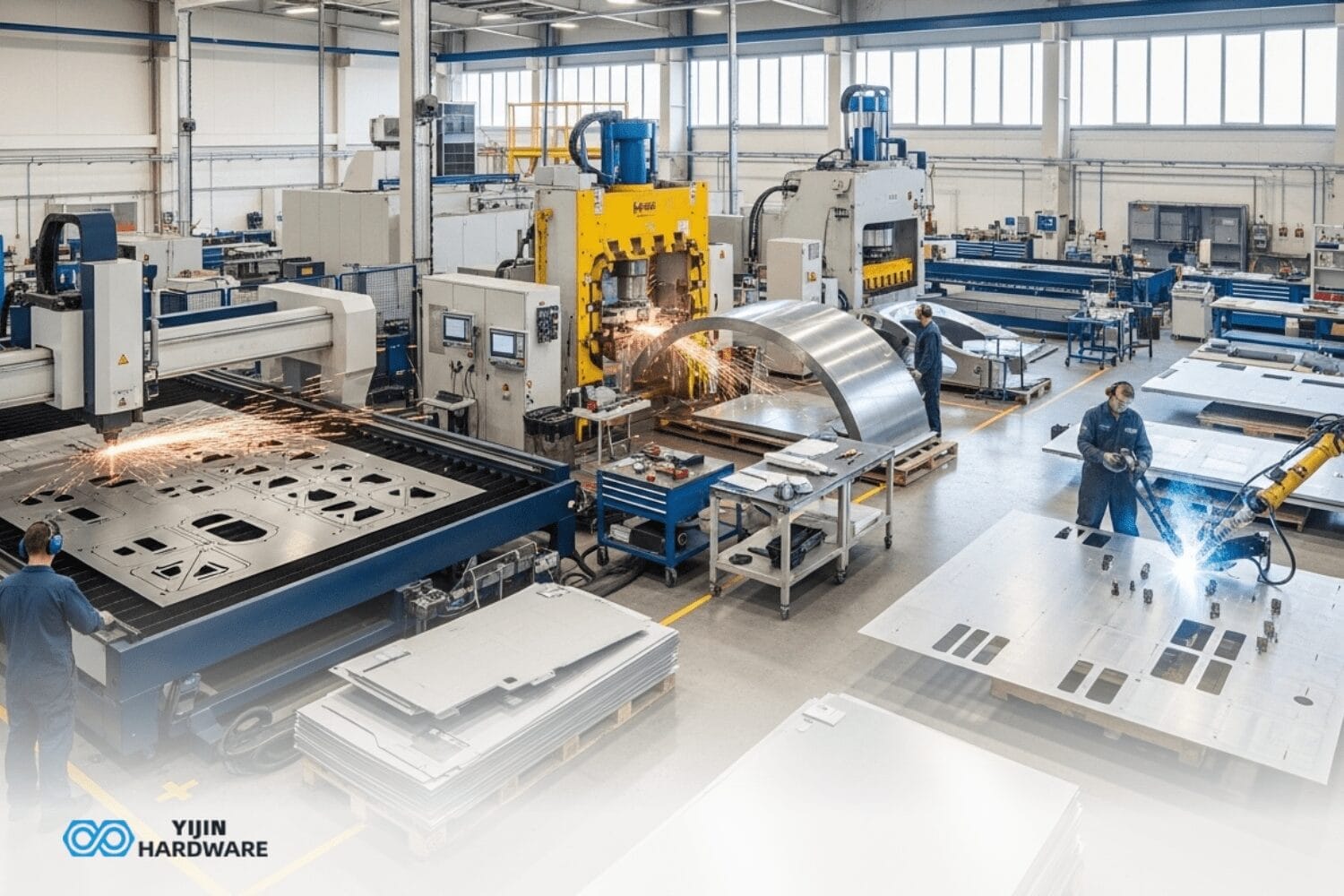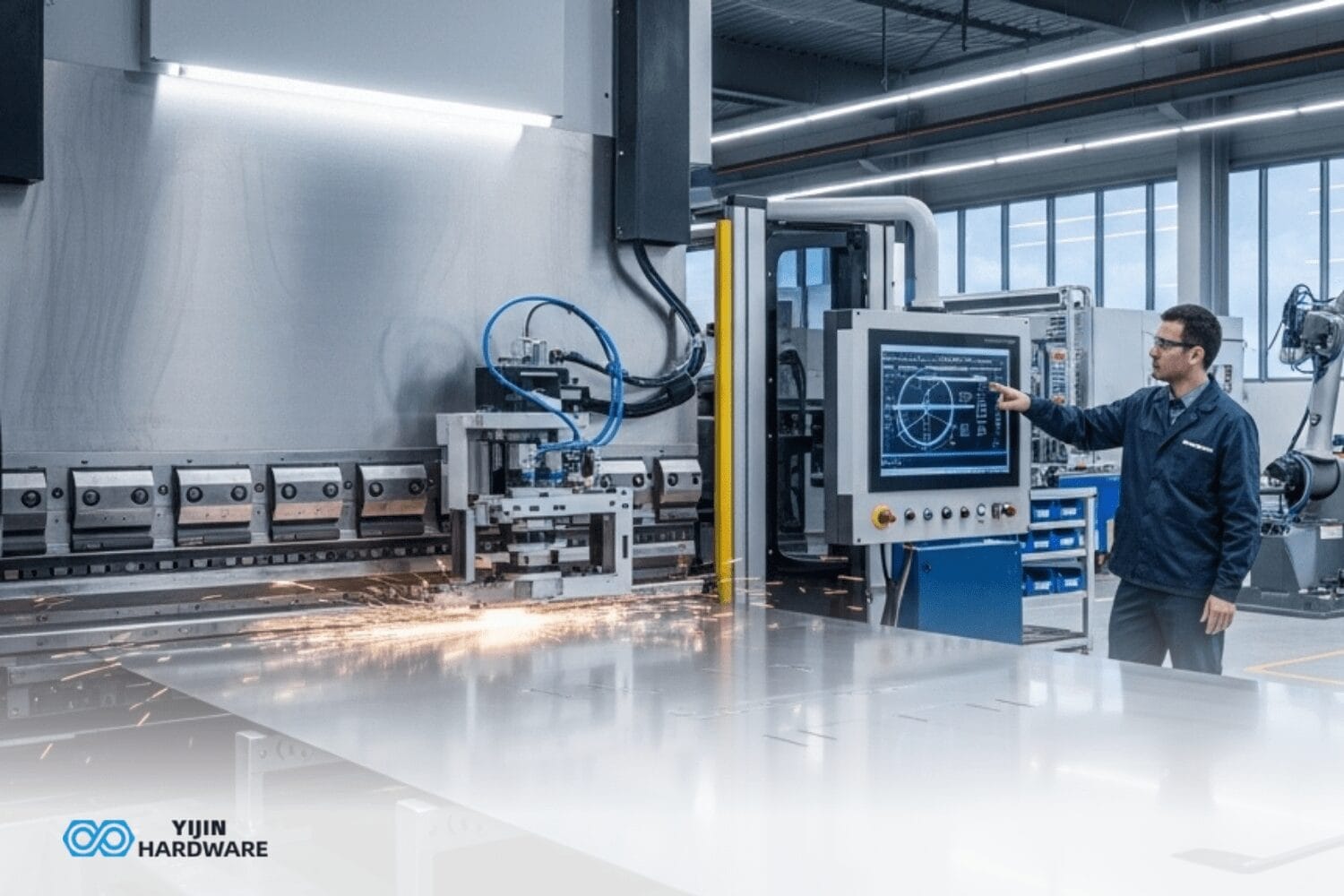CNC machining vs. 3D printing represents the fundamental choice between two dominant manufacturing technologies in today’s production landscape. CNC machining removes material from a solid block to create parts through subtractive manufacturing, while 3D printing builds objects layer by layer using additive manufacturing principles.
Yijin Hardware specializes in providing top-tier CNC machining services that deliver precision parts for diverse applications, helping clients determine the best way to make their components.
Key Takeaways
- CNC machining achieves precision tolerances of 0.005 mm, while 3D printing typically reaches 0.2 mm for dimensional accuracy.
- Metal parts from CNC machining retain 100% of native material properties compared to 10–20% for many 3D printed parts.
- 3D printing excels at creating complex geometries with internal features impossible with traditional milling machine methods.
- CNC machining becomes cost-effective at production volumes exceeding 50 to 100 units due to amortized setup costs.
- Hybrid approaches combining both CNC machining and 3D printing offer the best balance of precision and geometric freedom.
What is the Difference Between CNC Machining and 3D Printing?
CNC machining is a subtractive manufacturing process that removes material from a solid block using computer numerical control cutting tools to create the desired part. 3D printing, conversely, is an additive manufacturing process that builds 3D objects layer by layer from raw material, adding only what’s needed for the final design. This fundamental difference between CNC and 3D printing directly impacts material efficiency, design possibilities, and production economics.
These manufacturing methods share similar digital workflows—both start with CAD design and generate machine instructions (G-code)—but diverge dramatically in execution. While CNC machining cuts away excess material, resulting in significant waste (typically 60-90% of the original stock), 3D printing uses only the exact material needed for the part, achieving 90-95% material utilization rates in most cases.
How do CNC Machining and 3D Printing Work?

CNC machining works by following programmed instructions that control cutting tool movements to remove material from a solid block until the desired shape remains. The manufacturing process begins with creating a 3D model in CAD software, followed by CAM programming to generate G-code instructions that direct precise tool movements across multiple axes.
Multi-axis CNC machines can approach the workpiece from various angles, with common machining operations including milling (using rotating cutting tools), turning (rotating the workpiece against a stationary tool), and drilling.
3D printing works by depositing material layer by layer according to a digital 3D file that has been “sliced” into cross-sections. Common 3D printing technology includes Fused Deposition Modeling (FDM), which extrudes thermoplastic filament through a heated nozzle; Stereolithography (SLA), which uses light to cure liquid resin; and Selective Laser Sintering (SLS), which uses lasers to fuse powder materials.
What Materials Can Be Used in CNC Machining vs. 3D Printing?
CNC machining supports a wide range of materials, including metal (aluminum, steel, titanium), plastics (ABS, nylon, acrylic), wood, composites, and even ceramics with almost no limitations on material properties. The material selection for CNC is primarily limited by machinability rather than process compatibility, allowing for production with virtually any solid material that can be cut using machine tools.
3D printing materials are more restricted, with the most common technologies using specialized thermoplastics delivered as filament (PLA, ABS, PETG), photopolymer resins, or specific metal powders for metal 3D printing designed for the printing process. Although 3D printing technology options have expanded significantly, they remain more limited than CNC machining, with many industrial materials unavailable or requiring specialized equipment.
The machining process preserves 100% of the base material’s mechanical and thermal properties, since it simply removes portions without altering the remaining material structure. In contrast, 3D printing often creates parts with anisotropic properties (different strengths in different directions) and reduced mechanical performance compared to the base material.
How do Precision and Tolerances Compare Between CNC and 3D Printing?
CNC machining achieves significantly higher precision with typical tolerances of ±0.005 mm (0.0002”), enabling the creation of parts with exacting specifications and excellent repeatability. The precision comes from rigid machine structures, high-quality cutting tools, and precise motion control systems that maintain accuracy even across large production runs. CNC mills and lathes can consistently hold tolerances that are crucial for functional mechanical components.
3D printing generally offers lower precision with standard tolerances around ±0.2 mm (0.008”), though advanced industrial systems can reach ±0.05 mm in optimal conditions. Layer lines often create visible surface steps on curved or angled surfaces, requiring post-processing to achieve smooth finishes comparable to CNC machining.
Surface finish quality follows a similar pattern, with CNC capable of mirror-like surfaces (Ra 0.2-0.8 μm) through proper tooling and cutting parameters, while 3D printing typically produces rougher surfaces (Ra 3-25 μm) characterized by visible layer lines or fusion patterns.
Which Manufacturing Method Offers Greater Design Freedom?
3D printing offers significantly greater design freedom by enabling complex internal geometries, organic shapes, and intricate features impossible to produce with traditional machining. Hollow structures, internal channels, and lattice patterns can be created without regard for tool access limitations. This design freedom allows for part consolidation, weight reduction, and function optimization previously impossible in manufacturing.
According to the National Library of Medicine, 3D printing offers you better design freedom because you can achieve complex geometries and internal structures that are difficult to get right with CNC machining.
CNC machining faces geometric constraints due to tool access requirements, with limitations on internal features, undercuts, and complex organic shapes. Traditional machining requires considerations for tool approach paths, fixturing methods, and minimum internal radii based on cutting tool diameters, often necessitating design compromises or multipart assemblies.
| Feature Type | CNC Machining | 3D Printing |
|---|---|---|
| Internal channels | Limited by tool access | Unrestricted, even complex paths |
| Lattice structures | Not feasible | Easily created |
| Organic shapes | Difficult, requires 5-axis | Naturally suited |
| Thin walls | Challenging below 0.5 mm | Possible down to 0.3 mm |
| Integrated hinges | Requires assembly | Can be printed in one piece |
| Threaded features | Excellent, high precision | Possible but lower precision |
How do Costs Compare Between CNC Machining and 3D Printing?
CNC machining typically involves higher initial setup costs due to programming time, fixture creation, and tool selection, but achieves lower per-unit costs at scale as these expenses are distributed across larger production runs. The cost structure favors medium to high-volume production, with parts often becoming economical at quantities above 50 to 100 units.
3D printing features minimal setup costs with little to no tooling requirements and simplified digital preparation, but maintains nearly constant per-unit costs regardless of quantity due to consistent material and machine time requirements. This makes it highly economical for prototyping or low-volume production (1 to 10 units) but increasingly expensive compared to CNC as quantities increase.
For a typical small, moderate-complexity part (50×50×25 mm):
- 1 to 5 units: 3D printing is typically 40-60% less expensive
- 10 to 50 units: Cost comparable between methods (complexity dependent)
- 50+ units: CNC machining is typically 30-70% less expensive
When Should You Choose CNC Machining Over 3D Printing?
CNC machining should be chosen when your project requires tight tolerances, superior mechanical properties, or consistent surface finish quality that meets engineering specifications. Parts requiring full material strength, high temperature resistance, or specific certified materials benefit most from CNC manufacturing, which preserves 100% of the base material’s properties. Using CNC for these applications ensures long-term durability and reliable performance under mechanical or thermal stress.
Production volume significantly influences this decision, with CNC becoming increasingly cost-effective at quantities above 50 units due to amortized setup costs. The economics clearly favor machining as volumes increase into hundreds or thousands of parts, especially for simpler geometries with fewer machining operations.
When Should You Choose 3D Printing Over CNC Machining?
3D printing should be chosen when your project requires complex geometries, internal features, or organic shapes that would be difficult or impossible to machine conventionally. Parts with lattice structures, consolidated assemblies, or weight-optimized designs benefit most from additive manufacturing’s freedom from traditional manufacturing constraints.
3D printing may require specialized design considerations, but it enables revolutionary part designs that can significantly reduce weight or improve performance.
Prototyping and product development cycles benefit immensely from 3D printing’s rapid turnaround times and minimal setup requirements. New designs can be produced in hours rather than days, enabling multiple iterations and faster innovation cycles without significant cost penalties for design changes.
What are Hybrid Manufacturing Approaches?
Hybrid manufacturing combines CNC machining and 3D printing technologies to leverage the strengths of each process while minimizing their individual limitations. Parts might be 3D printed to achieve complex geometries and then CNC machined in critical areas to achieve precise tolerances and superior surface finish, where functionally required.
This integration of additive and subtractive processes creates opportunities for optimized manufacturing that weren’t previously possible. Common hybrid approaches include:
- Near-net shape printing followed by precision machining to maintain complex geometries while ensuring precision where needed
- Machined substrate with printed features added for adding complex features to precision-machined base components
- Complex printed cores with machined functional surfaces to combine lightweight, optimized internal structures with precise mating surfaces
What are The Main Industry Applications For Each Method?
CNC machining dominates in industries requiring high precision, certified materials, and established quality processes, including aerospace (structural components, engine parts), automotive (transmission components, precision molds), medical (surgical instruments, implants), and industrial equipment. CNC milling machines excel when producing parts that must withstand significant mechanical or thermal stress.
Metal 3D printing vs. CNC machining presents different use cases, with 3D printing excelling in applications benefiting from design freedom, customization, and rapid development cycles. 3D printing use cases include medical (custom prosthetics, anatomical models), aerospace (topology-optimized brackets, ducting), consumer products (custom goods, limited editions), and architecture (complex models, custom fixtures).
When determining which manufacturing method to use, consider:
- Precision requirements (±0.005 mm = CNC machining, ±0.1 mm = either method)
- Material requirements (certified material properties = CNC machining)
- Geometric complexity (complex internal features = 3D printing)
- Production volume (1 to 10 units = 3D printing, 50+ units = CNC machining)
- Timeline requirements (immediate single part = 3D printing)
What is the Future of Manufacturing Technology Integration?
Manufacturing technology integration is advancing toward seamless digital workflows that intelligently assign production methods based on part requirements. Artificial intelligence systems now analyze designs to recommend optimal manufacturing strategies, whether CNC milling, 3D printing, or hybrid approaches combining 3D printing with CNC machining.
The distinction between CNC machining vs. additive manufacturing is becoming less rigid as technologies evolve. Modern manufacturing facilities increasingly use both processes in complementary ways:
- Design Once, Manufacture Appropriately: Parts are designed for optimal production method
- Scalable Manufacturing Pathways: Prototyping with 3D printing, production with CNC machining
- Function-Based Manufacturing: Different features of the same product made with different technologies
Yijin Hardware: Top CNC Machining Solutions
As specialists in top-quality CNC machining services, Yijin Hardware helps clients navigate between 3D printing and CNC machining to select the optimal manufacturing method for each project. Our engineering team combines deep expertise in traditional precision machining with advanced knowledge of additive manufacturing capabilities, providing technology-agnostic manufacturing solutions tailored to your specific requirements.
Whether you need a prototype quickly developed through 3D print technology or production-ready metal parts through our CNC mill setups, our comprehensive manufacturing capabilities ensure you receive the highest quality components optimized for your application needs. Contact us to learn more about our CNC machining services.
CNC Machining and 3D Printing FAQs
Which manufacturing method is faster?
CNC machining is much faster than 3D printing for simple parts and larger production runs once setup is complete, with actual cutting time often measured in minutes. The case of CNC vs. 3D printing build times shows that 3D printing is determined primarily by part volume, regardless of complexity, making it slower for large parts but competitive for small, complex items.
How does part size affect manufacturing method selection?
Part size significantly impacts manufacturing method selection, with CNC machines capable of producing much larger components limited only by machine bed dimensions, typically up to several meters. Typically, 3D printers are constrained by build volumes, usually under 300 mm in consumer/prosumer equipment, though industrial systems can reach 1 m+ in specialized applications.
What are the minimum feature sizes possible with each method?
CNC machining minimum feature sizes are determined by cutting tool geometry, with typical minimum internal corner radii of 0.1-0.5 mm depending on tool size and material. 3D printing feature sizes vary by technology: FDM generally achieves 0.5 mm minimum features, SLA can reach 0.1 mm, and SLS approximately 0.3 mm for stable features.
How do you design parts differently for each process?
Designing for CNC machining requires considering tool access paths, fixturing methods, and avoiding thin walls or deep pockets with small radii. Designing for 3D printing focuses on orientation to minimize support structures, appropriate wall thicknesses, and consideration of anisotropic strength properties, with features aligned to the printing direction for maximum strength.
What are the advantages and disadvantages of each method?

The advantages and disadvantages of CNC machining include superior precision and material strength, but limited geometric freedom and higher setup costs. The pros and cons of CNC vs. 3D printing highlight that 3D printing offers unmatched design flexibility and lower startup costs, but typically delivers lower-strength parts with a rougher surface finish.
Back to Top: 3D Printing vs. CNC Machining









